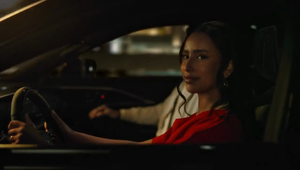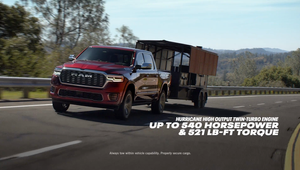
Fusing Design with Californian Coastline for Range Rover and Condé Nast

For this Range Rover x Condé Nast collaboration, Porch House director Lukas Dong worked closely with the teams at Jaguar Land Rover and two iconic Condé Nast brands, Architectural Digest (AD) and Traveler, to draw a thread between the masterful designs of interior designer and ceramicist Jonathan Adler, the natural beauty of the California coastline, and the Range Rover Sport model itself.
Filming the car as it journeyed along Highway 1 from LA to Big Sur and its final destination at the ‘Range Rover House’ in Monterey, the film ‘View From the Top’ captures the breath-taking landscape and equally stunning architecture along the way - accompanied by Jonathan’s voiceover of philosophical design musings.
Speaking to LBB’s Ben Conway, the director discusses how he explored the similarities between the attention to detail required when designing a space to that of Range Rover’s design, and how he seamlessly melded the theme of exceptional design with the natural cliffside surroundings.
LBB> This project draws parallels between Jonathan Adler’s design philosophy, the beautiful California coastline, and the Range Rover - what was the brief like, and what ideas immediately came to mind when playing with these elements?
Lukas> What stood out to me during our first conversations was this idea of the Range Rover Sport as an enabler – a car that blends stunning design with the power to immerse you in your surroundings. This unique contrast in the brief sparked an idea to explore the interplay between movement and tranquillity along the coast. I was very inspired by iconic California photography from artists like Ansel Adams and Edward Weston. These photographers created striking images that dance between light, movement and shape, and have a feeling of both stillness and motion that needed to be felt in this project.
Lastly, I wanted there to be a subconscious feeling inspired by the actual experience of driving up the coast. Look to your right – rock walls fly by at 70mph. Look to your left – endless, seemingly static ocean drifts by. I knew sound design and the edit’s pacing would help build this nuanced rhythm between these worlds.
LBB> You had several client voices to listen to - Condé Nast and Jaguar Land Rover - as well as the input from Jonathan and your DoP. What did you take from each of them, and how do you stay focused and deliver your own strong directorial vision with so many other voices in the mix?
Lukas> Commercial filmmaking is always a bit of a balancing act: knowing how to listen, when to ask for help, and why it’s so important to fight for your ideas. I am grateful to have had a collaborative team from both Condé Nast and Range Rover that supported my vision and brought new ideas to the table.
I’m always interested to hear from the automotive designers on their favourite features and how best to highlight them. The Range Rover team knows the car inside and out and played a big role in making sure it was shown in its best light. I worked with Condé Nast’s team to curate a list of tasteful locations that Jonathan would stop at along his journey that both made sense for him and for any viewer aspiring to take an elevated weekend trip.
Jonathan’s personal connection with the Big Sur area also became a big part of our approach to the film’s voiceover. His comments on the grandeur of Big Sur’s scale, as well as the singularity of nature’s materials segued perfectly into design discussions on the car itself. Lastly, among many other things, Paul Theodoroff (DP) is a master at designing dynamic running footage. He brought some beautiful and intricate moves that showcased the car in action, in perfect harmony with the world around it, a key theme for this project.
In terms of staying focused, it usually comes down to a feeling. I know when I’m avoiding the difficult decision, and I’ve learned the hard way that when you listen to everyone all the time, the end product is neither here nor there.

LBB> How did you want to combine these aforementioned elements? What shots and production choices particularly accentuate the shared themes and visuals between the three?
Lukas> I was very drawn to the theme of ‘layering’ and using this feeling of unfolding as an interesting tool to draw a thread between the world of architecture, the Range Rover’s design, and the California coastline. Similar to a low hanging hallway that opens into a double-height living room, driving the windy curves of Highway 1 spurs a rhythm of tension and release as the mountain ranges hide and reveal themselves.
Paul and I wanted the viewer to feel this sense of layering through consistent, forward moving shots that reveal new environments and design elements. For example, there are a few long driving shots that open on the serene environment, pull out to reveal a road, and then the car on the road, and finally send the car off, speeding away.
LBB> You worked a lot with an arm car on this project - what challenges did you face with this? And equally, what shots or effects did this tool allow you to create?
Lukas> We had so much fun driving up and down Highway 1 and it was hard to make any of it look… bad. I wanted to stick to the two-lane roads for that windy, adventurous look. With a narrower road, we were limited in some of the arm car’s ability to pull off wide manoeuvres around the Range Rover. In addition to some high-speed counter moves, we ended up using foreground elements to capture the speed and ‘sport’ of the car. One of our stretches of road had a bridge where we threw the arm over a railing to accentuate the speed. Paul and everyone in the arm car somehow nailed this move every time with precision.
We also had an amazing cliffside location, but its overgrown and rocky pathways presented a few challenges. As it wasn’t very accessible and we were tight on time, we decided to use the arm car as a crane at times, locked off on the cliff, achieving those sweeping beauty shots, mimicking the feel of a technocrane or jib. In the end, despite the bumpy roads, three-hour company moves, and lots of precise movements, the arm car team from Filmotechnic did a beautiful job and added a lot of unique moments to this piece.

LBB> What’s so special about this stretch of coastline? What makes it a director and DP’s dream location to shoot?
Lukas> There are so many things that made this string of locations a dream. We felt very connected to nature each step of the way and a lot of the time, it felt like we were driving right on the edge of the world. The weather was another great textural layer. Clear skies brought a magical view of the never-ending horizon, and low hanging fog brought a distinct, brisk Northern Californian moodiness. We got lucky that our locations at high noon were met with heavy fog and sunset was fully clear.
LBB> You only had two days to shoot - how did you make sure you were prepared? Were there any opportunities for on-set improvisation?
Lukas> I am always pushing for more time, but there is a beauty in working within some limitations (I will probably kick myself for saying this). Knowing we only had two days, I was challenged to pre-visualise the whole edit and its pacing. This let me trim the shotlist down to the essentials, making sure each moment had a reason to be there. My biggest gripe with extensive storyboarding is that most times the best shot doesn’t present itself until the day of, and it’s frightening to have a whole crew prepare for a shot that may not be the one. But you do have to start somewhere to make sure the piece works in its most basic form, even if there is more flavour waiting to be uncovered.
Projects like this with lots of footage always require a dance between big set ups and embracing ‘less-is-more’ moments. As more and more ideas came and the schedule got tighter and tighter, Paul and I sat down and established our priorities. We had a lot of factors on our side: stunning locations, unique architecture, a beautiful car and lively talent. With that in mind, all we had to do was figure out when the daylight would bring all these things together. During our scouts, we did a few light studies and mapped out all our key moments so we could give ourselves time to be very deliberate with beauty shots of the car, lighting and rehearsing those until we were happy.

LBB> Tell us a bit about the location scouting process - how did you find this stunning house to work with?
Lukas> We were lucky to have been provided this house by Range Rover so that was a big win up front. The other locations were a bit more of a challenge. There happened to be a landslide along Highway 1 a few weeks prior, which forced us to pivot. It instantly took most of the iconic California locations off the table, but our producer and location scout did a great job of finding some creative workarounds. We went through dozens and dozens of grim options before we found our cliff and running footage locations, and we drove it a few times as a team before making our decision.
LBB> What was your equipment set-up for these beautiful sequences?
Lukas> We paired the Alexa 35 with rehoused Canon FD lenses. It was both Paul’s and my first time shooting on the Alexa 35 and when speaking he mentioned really liking how it handles highlights in its own way. He said, “I almost immediately noticed the difference in light and texture that worked so well for this piece specifically.”
All the aerial work was shot by Override Films on a DJI Inspire 3, and a handful of pickup shots with a sneaky handheld Leica SL2-S rig, something I’ve been experimenting with on recent projects when we need to steal some shots while the main camera is being built or stuck in traffic. I use a series of Leica M Rangefinder lenses which, so far, has been a perfect pair for stealing moments right before we go into overtime.

LBB> What was the most fulfilling part of this project for you personally?
Lukas> It’s so hard to have a full team of go-to people on a travel job like this. I am thankful to Porch House for making the extra effort to bring out some of the best people across all disciplines and for being there with me to bring this project to life.












